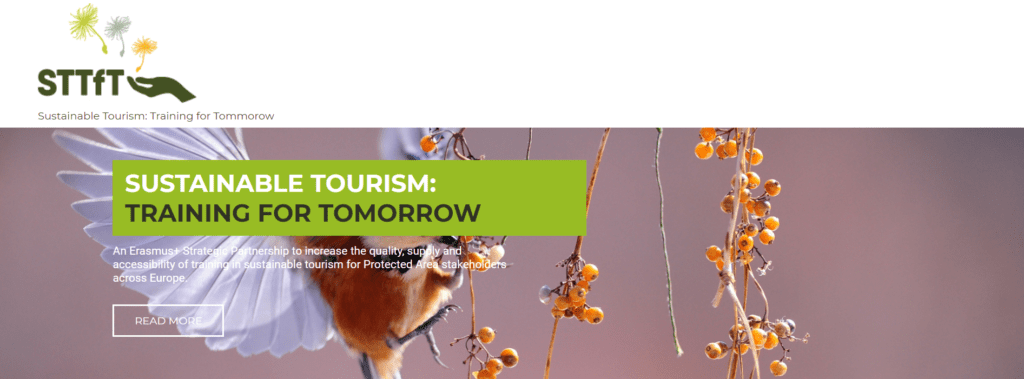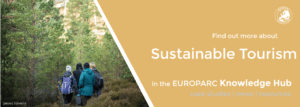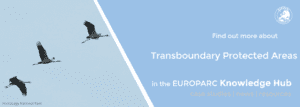A training needs analysis for Sustainable Tourism in Protected Areas: report available
Within the Erasmus+ project ‘Sustainable Tourism: Training for Tomorrow’ the consortium consisting of 6 partners, has identified the key training needs of professionals working on sustainable tourism in protected areas (PAs). To this end, a literature review, mapping of relevant competences, and European-wide survey among PA stakeholders were carried out.
Some of the key results include a top 3 of knowledge and skill areas that were rated as most important, a top 3 of knowledge and skills for which respondents lack most knowledge and the overall training gap they are experiencing.
The 3 most important knowledge and skills areas are:
1) “knowledge on how to develop a communication strategy”
2) “tools to reduce environmental impact from organisational activity”
3) “knowledge of how to develop, design and/or use attractive and engaging communication tools”
The 3 knowledge and skills areas for which respondents lack most knowledge are:
1) “methods to influence and encourage support for conservation funding by visitors and businesses”
2) “knowledge of national and international initiatives, networks and specialist groups that support professionals developing sustainable tourism and recreation in and around PAs”
3) “best practices on partnerships / formal agreements that can support economically local tourism businesses, and related products and services”
Skills for Sustainable Tourism in Protected Areas: a training needs analysis
The overall training gap analysis, taking into account both the respondents’ level of importance (i.e. relatively important) and level of knowledge (i.e. relatively little knowledge about), results in the following 3 main skills that need to be focussed on in the near future:
· “tools for monitoring tourism impacts on the environment, economy and communities”
· “methods to define and measure sustainable tourism indicators”
· “knowledge of national and international initiatives, networks and specialist groups that support professionals developing sustainable tourism and recreation in and around protected areas”.
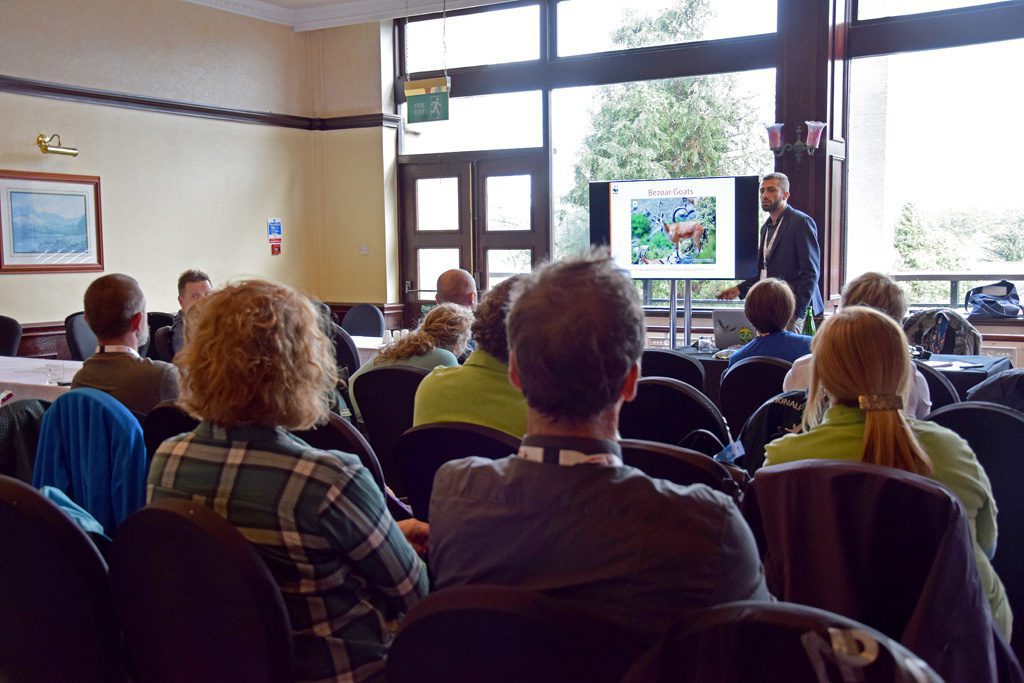
Communications workshop at EUROPARC Conference 2018
For some (large enough) groups of respondents, a further detailed analysis could be conducted by country (France, Italy and Spain), and by profiles of respondents working in a specific type of organisation (protected area management, business and the public sector).
Skills for Sustainable Tourism in Protected Areas – Training Needs Analysis Report
Coming soon: a training platform for Sustainable Tourism professionals!
Based on the collective know-how of the project partners, which include universities, business owners and protected areas working on sustainable tourism, a free, online learning platform with sustainable tourism material for Protected Area stakeholders is developed addressing these needs. Access to the platform will be free of costs. Keep tuned, the platform will be announced soon!
Erasmus+ project ‘Sustainable Tourism: Training for Tomorrow’
This project is co-funded by the Erasmus+ programme of the European Union. It aims to increase the quality, supply and accessibility of training in sustainable tourism for Protected Area stakeholders across Europe. The consortium members are: Hasselt University (Belgium); University of Hull (United Kingdom); EUROPARC Federation (Germany), the network of ecotourism professionals (AEE) in Spain, Ente Parchi Emilia Occidentale (Italy) and Montagne de Reims Nature Regional Park (France).
Financing the Natura 2000 management: challenges & solutions
Workshop 1.1: Financing Natura 2000 management
During the Conference 2019 in Latvia, EUROPARC held a number of workshops to discuss diverse topics relevant for Protected Areas management. In case you have not attended, or want to read about their outcomes, a series of online articles summarises their content.
How much money do we need for effective Natura 2000 management?
In the workshop, inspired by the expertise of Micheal O’Briain – Deputy Head of Nature Protection Unit, DG Environment – European Commission, of Michael Hosek – EUROPARC Federation, Natura 2000 Commission chair and Juris Jātnieks – former director of the Nature Conservation Agency of Latvia, we tried to identify the main issues currently hampering successful planning and financing of Natura 2000 management. Taking advantage of the wide expertise of delegates, we also worked on possible solutions and action priorities.
The Natura 2000 network, which widely overlaps with nationally and regionally designated Protected Areas, is the largest network of protected sites in the world, with 27863 sites, covering about 18% of EU land and 9% of EU seas.
Several aspects were considered and discussed during the meeting. Among others:
From plans to management
If at a first glance, the need for funding seems to be the main urgency, the challenges appear to be more complex and wide. Money is not the solution per se, there are other crucial aspects to be considered: management and financial needs have to be clear; objectives have to be realistic but also ambitious; plans have to be developed consequently and be coherent with needs and objectives; plans with clear priorities can then be elaborated. Only this way we can ensure the management can be coherent and as effective as possible.
Prioritised Action Frameworks – PAFs
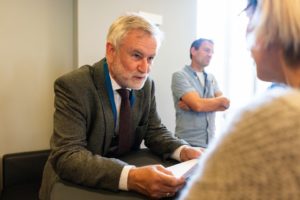
Micheal O’Briain at the EUROPARC Conference 2019.
For the effective management and restoration of this wide and complex network, ensuring sufficient funding is essential, with required investments estimated at about EUR 12 billion per year. Therefore the European Commission, with a view to optimise the use of EU funds has asked Member States to prepare what are called Prioritised Action Frameworks (PAFs). Those are made to identify strategic needs and funding priorities for investment in Natura 2000 and related Green Infrastructure.
These key planning tools will not only be directly relevant to helping ensure ambitious nature investments under the key sectoral funds (Common Agricultural Policy, Cohesion Policy, European Maritime and Fisheries Funds) but also for nature and biodiversity projects under the new EU LIFE regulation.
To effectively implement management plans and conservation measures, a careful and strategic planning and management of financial resources is therefore crucial. For this, PAFs – Prioritised Action Frameworks – developed at national/regional levels by the EU countries – are strategic tools.
Download the presentation ‘Strengthening investment in Natura 2000 and wider biodiversity under EU funds – the role of Prioritised Action Frameworks (PAFs) and LIFE funding‘, by Micheal O’Briain.
Current challenges for N2000 network
- The Natura 2000 network still needs to be finalised: there are still gaps mainly in the marine sector.
- There is the urgency to ensure that necessary management and restoration measures are in place, while promoting a better integration with other sectors (in particular with agriculture).
- Communication quality and effectiveness has to be improved. Weak communication of the opportunities and benefits that the Natura 2000 network provides. Improving communication is crucial to engage with other public sectors, with stakeholders and other partners.
- Lack of community and stakeholders engagement: solutions for Natura 2000 management have to be designed together.
- In general the environmental sector is too self oriented and lacks interaction with different sectors. Different perspectives need to be integrated. In particular, more connections to be established with the economic sector, with enterprises, agriculture and local communities.
Download the presentation ‘Introduction and overview from across Europe‘, by Michael Hosek.
Planning and management tools in Latvia
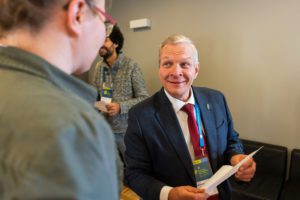
Juris jatnieks at the EUROPARC Conference 2019.
A National Conservation and Management Program for Natura 2000 sites has been developed for the whole country, for the period 2018 – 2030. This includes a prioritised list of management measures for all terrestrial NATURA 2000 area. A precious tool that helps to address priority measures for the qualifying features and the main conservation values of each particular NATURA2000 site. A crucial knowledge base for developers of site management plans, protected area site managers, spatial and development planners of municipalities and project managers.
There are also specific guidelines for protected habitat management. The guidelines describe field methods, suggest how to manage the existing habitat to improve status, or restore the habitat whenever it is possible and necessary. User-frendly indicators are included to evaluate the state of habitats, together with conclusions from experiments of management methods for dunes, grasslands, freshwater, mire and forest habitats.
Download the presentation ‘The Latvian experience in financing Natura 2000 and protected areas management’, by Juris Jātnieks.
Recommendations for action
Improving dialogue and building better relationships within the Natura 2000 network is clearly a priority. Specific knowledge, expertise and new skills are needed. The Natura 2000 network and wider protected area family would surely benefit from trained moderators and facilitators, with specific communication expertise. Those would help engaging with partners and stakeholders, help managing conflicts and contribute to improve the wide communication of N2000 benefits. Strategic communication plans have to be in place, data and facts have to be updated regularly, ready for dissemination. A wider audience have to be addressed and engaged to improve acceptance and support.
Together with strategic planning, good governance with clear decision making processes (who, what, how, when…) have to be in place: those are also crucial to make the management more effective.
Management and restoration practices and methods need to be shared and accessible.
Natura 2000 has to be well integrated in the overall National/Regional planning and management, as a crucial part of a unique ecological network, which includes other designated protected areas and the connecting green infrastructures.
The EU will be working on:
- European Green deal;
- A new EU Biodiversity Strategy to 2030 (Its structure will be developed by beginning of 2020);
- Improving the integration of biodiversity priorities within other relevant policies and funding;
- Strengthen the LIFE program and increase the resources allocated;
- Align climate and biodiversity debates.
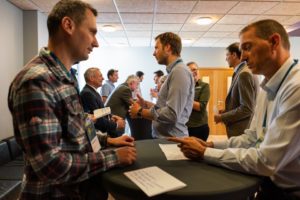
Discussion in the Workshop 1.1 on financing Natura 2000 management.
EUROPARC shall:
- consider in the new strategy how contribute leading the coordination of the Natura 2000 network.
- continue working closely with the EC, influencing and informing priorities, while contributing to create opportunities for future.
- Engage and involve parks to improve the management of Natura 2000 sites.
- Support site managers to improve knowledge and expertise in Communication and other “soft – skills”.
The Star Awards winners need your votes!
The EUROPARC Star Awards aims to champion the effort and investments made by tourism businesses working with our Sustainable Destinations across Europe. An online public voting is now running, to select one winner out of the five awarded, who will be invited to present their business at EUROPARC Conference 2020.
Vote now!
This year for the first time, part of the Charter Award Ceremony was dedicated to the announcement of the EUROPARC Star Awards winners.
The Star Awards announced 5 impressive businesses that have been active in the protection of their natural and cultural heritage, who are innovative, work to reduce environmental impacts, and inspire their clients in terms of sustainable behavior.
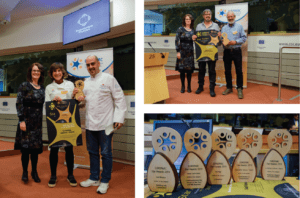
Currently, an online public voting is active! Help us choose the finalist that you want to hear at the next EUROPARC Conference 2020. The business chosen by the public, together with a representative of the Protected Area authority where it operates, will be invited to join us in Austria and give a speech at the EUROPARC General Assembly.
Get to know the winners
EUROPARC awarded the prize in five categories – Contribution to Conservation, Reducing Impact on the Environment, Building my Community, Communicating the Values of my Park and Business, and Innovation.
Reviving the ancestors’ knowledge
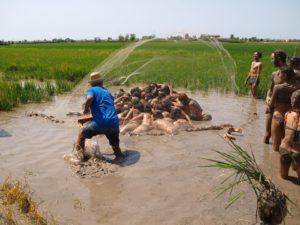
“Tirant to rall a l’Arrossar” – Photo: Delta Polet
The winner in the category Contribution to Conservation is Deltapolet Natura i Sabers, partner of Delta del Ebro Natural Park in Catalonia.
Living in a period when the region’s traditional practices started to disappear as machines were slowly taking over, Mr. Polet decided to maintain the knowledge of his ancestors. His philosophy is still alive today, followed by Deltapolet’s owner and Polet’s son, who has one main goal: remain able to get and process resources without using machines or chemical products.
A flavour of self-sufficiency
In the category Reducing impact on the environment, the jury chose La calma, cultura i lleure, partner of Montseny Natural Park in Catalonia.
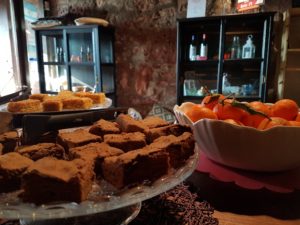
Dessert buffet, La calma, cultura i lleure.
La calma, cultura i lleure, (meaning “The calm, culture and leisure” in Catalan) runs a 100% energy efficient restaurant El Bellver in El Montseny Natural Park and Biosphere Reserve. Using spring water from the Montseny massif and solar panels, energy accumulation batteries, movement sensors and an inverted gasification biomass boiler with thermal buffer tank, El Bellver became 100 % self-sufficient in terms of energy and water. Concerning their menu, around 80% come from the region or from Catalonia.
Following the steps of locals
Sud Randos, partner of Cévennes National Park, is the winner in the category Building my Community.
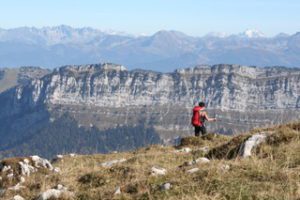
Photo: Sud Randos
When organising tourism experiences, farmers, artisans, craftsmen, artists, and local nature are the lead actors and objects of discovery for visitors. Sud Randos’ infrastructure takes care of each detail, making sure that most of the equipment, material or food come from fair trade, local businesses, and organic production. With culture and local traditions at the core of their touristic activities, Sud Randos strengthen the community and support preservation of traditional practices with modern incomes.
Pioneers in sustainable mobility
The winner in the category of Innovation is For Play, partner of Coastal Dunes Regional Park in Italy.
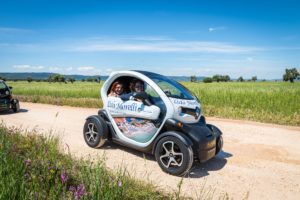
Photo: For Play
For Play’s mission is to allow visitors to explore the region, while following the principle of sustainable mobility. Equipped with a fleet of colourful electric cars, the company creates a new way to move around the Coastal Dunes Park.The cars are provided with itineraries, allowing visitors to spread and discover historical sites and private areas that are not accessible by other means.
A hotel that educates its guests in sustainability
Finally, in the category focusing on Communication of the Park’s and the Business’ Values, the winner is Hotel Caminetto, partner of Adamello Brenta Natural Park in Italy.
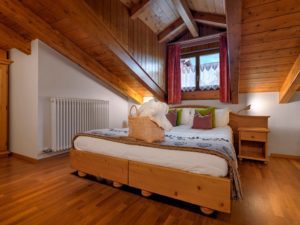
Photo: Hotel Caminetto
Hotel Caminetto can be considered a role model of a sustainable hotel committed to respect the environment and protect natural resources without giving up comfort. The communication policy of Hotel Caminetto aims to make guests fully aware of the culture and nature of the place, so they can better value it.
In the coming days and weeks, we will be publishing articles about each of the winner, to help you decide. Stay tuned!
The implementation of the Charter methodology is an opportunity to work side-by-side with local business partners and ensure that tourism can bring social and economic benefits to the local community. Learn more about how to become a Sustainable Destination.
For 30 years now is certain, never again an Iron Curtain
Foreign ministers meeting of Austria and Czech Republic 2019.
The Inter-Nationalpark Thayatal-Podyjí celebrated 30 years fall of the Iron Curtain by a series of transboundary events and were selected as the hosting location for the foreign ministers meeting of the Republic of Austria and the Czech Republic in 2019.
Article issued by the Transboundary Park Thayatal-Podyjí
Celebrating 30 years without the Iron Curtain
Since 1951 the Iron Curtain separated not just the people, but families, friends and neighbours of Austria and the Czech Republic for decades. While bridges are generally a symbol of connection, the Thayabrücke in Hardegg became symbolic for the separation in the Thayatal region. It is the only bridge in the border town of Hardegg that united inhabitants from both countries. The bridge was deprived of its deck and the access was blocked by a fence.
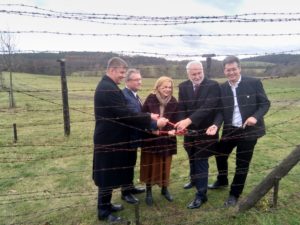
The ministers symbolically cut the barbed wire in the Nationalpark Thayatal-Podyji.
But in 1989, after a long struggle, the Iron Curtain has finally fallen. On the 26. December 1989, the locals from both countries met in Hardegg and climbed over to the neighbours on the other side of the river.
Since then a steady development brings the people from Austria and the Czech Republic progressively closer together. In 1991 the Nationalpark Podyjí was founded and then completed by the establishment of the Nationalpark Thayatal in 2000.
In 2019, 30 years after the fall of the Iron Curtain, both National parks celebrated this historic event with a whole series of transboundary events, such as excursions, concerts, an exhibition, a city festival and much more.
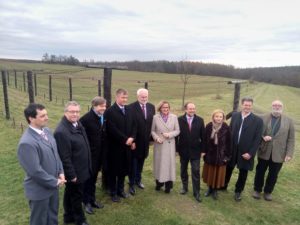
Foreign ministers meeting in the Thayatal-Podyji Transboundary Park.
The highlight and the reward for those transboundary efforts occurred on 29. November 2019, as the Inter-Nationalpark Thayatal-Podyjí was chosen to be the hosting location for the only meeting of the ministers of Austria and the Czech Republic in 2019.
The foreign minister of the Republic of Austria Mag. Alexander Schallenberg, was accompanied by the governess of lower Austria, Mag. Johanna Mikl-Leitner, and the ambassador of Austria in the Czech Republic, Dr. Alexander Grubmayr. The Czech Minister of Foreign Affairs Mgr. Tomáš Petříček attended together with the governor of south Moravia JUDr. Bohumil Šimek and the ambassadress of the Czech Republic in Austria, Dr. iur. Ivana Červenková.
Both delegations met on the Thayabrücke in Hardegg, right in the heart of the National parks, were they were welcomed by the director of the Thayatal National park, Christian Übl and the director of the Podyjí National park, Ing. Tomáš Rothröckl. Afterwards both delegations visited an original section of the former Iron Curtain in the Podyjí National park, where in a press conference both delegations emphasized the necessity of transboundary cooperation in Europe.
It was an honour for both National parks to have been chosen to host this event, which gave a lot of energy for the upcoming transboundary efforts of the Inter-Nationalpark Thayatal-Podyjí.
Read and download the Declaration published by the European Transboundary parks on the occasion of the 30th anniversary of the Berlin Wall Fall.
